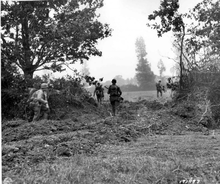Rhino tank
These defensive positions limited the ability of the American forces to coordinate large-scale attacks or receive sufficient and accurate artillery support.[4] Openings that did exist within the patchwork of hedges were already covered by German anti-personnel and anti-tank weapons; armor moving through these gaps attracted immediate defensive fire.However, military historian Max Hastings notes that Culin was inspired by "a Tennessee hillbilly named Roberts",[6] who during a discussion about how to overcome the bocage, said "Why don't we get some saw teeth and put them on the front of the tank and cut through these hedges?"[11][6] On 14 July, Lieutenant General Omar Bradley inspected the tank[11] and "watched in awe as a hedgerow exploded ... to make way for the Sherman bursting through".Initially this was done using steel salvaged from the thousands of obstacles, such as Czech hedgehogs, that the Germans had placed on the French beaches during the construction of the Atlantic Wall.[13] War correspondent Chester Wilmot wrote after the war that the German defensive plan to halt any American breakout was to hold the front line "very lightly and to concentrate upon holding the road junctions for a depth of three or four miles behind the front", with the intention of delaying any break-through by reducing the speed of the advance to the pace the infantry could manage.[14] Once Operation Cobra was launched, Allied troops were able to bypass the German positions using the Rhino tanks, thereby allowing the advance to continue, leaving the strong points to be dealt with by infantry and engineers.[6][18] Martin Blumenson states that while the device restored mobility in hedgerow country, it "was of little tactical value in the breakout, except possibly as a morale factor to the troops, since the tanks advanced on the roads, not cross-country.



M4A1 (76) WCanadaUnited KingdomUnited StatesWorld War IICurtis G. CulinHistory of the tankWorld War IInterwarCold WarPost–Cold WarAustraliaNew ZealandCzechoslovakiaFranceGermanyIsraelPolandNorth KoreaSouth KoreaSoviet UnionSwedenUkraineLight tankMedium tankHeavy tankSuper-heavy tankCruiser tankFlame tankInfantry tankMain battle tankTank destroyerTanketteAssault gunSelf-propelled anti-aircraft weaponSelf-propelled artillerySelf-propelled mortarMultiple rocket launcherRhinocerosbocageBattle of Normandysteel-beam beach defensive devicesad hocNormandy landingsNormandyArromanches-les-BainsCotentin PeninsulaBrittanyVendéehedgesfoxholescombat engineersOperation CobraNormandy campaignBulldozers79th Infantry DivisionXIX CorpsV CorpsM4 Sherman2nd Armored Division102nd Cavalry Reconnaissance SquadronMax HastingshillbillyCzech hedgehogsLieutenant GeneralOmar BradleyShermanMartin BlumensonAtlantic WallJohn MedarisUnited States Army Ordnance Departmentarc weldingStuartM10 tank destroyersRoyal Electrical and Mechanical EngineersCromwell tankChurchill tanksWar correspondentChester Wilmot2nd Infantry DivisionOperation BluecoatSteven ZalogaAllied technological cooperation during World War IIHobart's Funnies6th Guards Tank BrigadeBlumenson, MartinWilmot, Chester